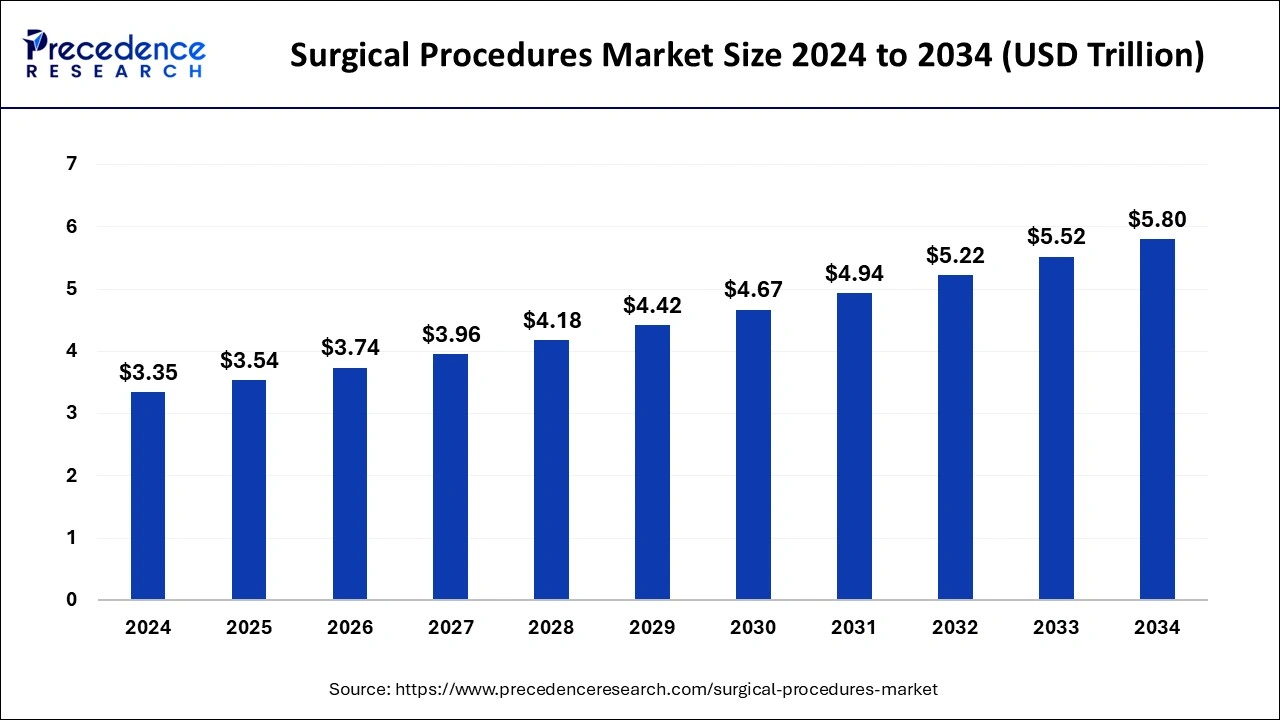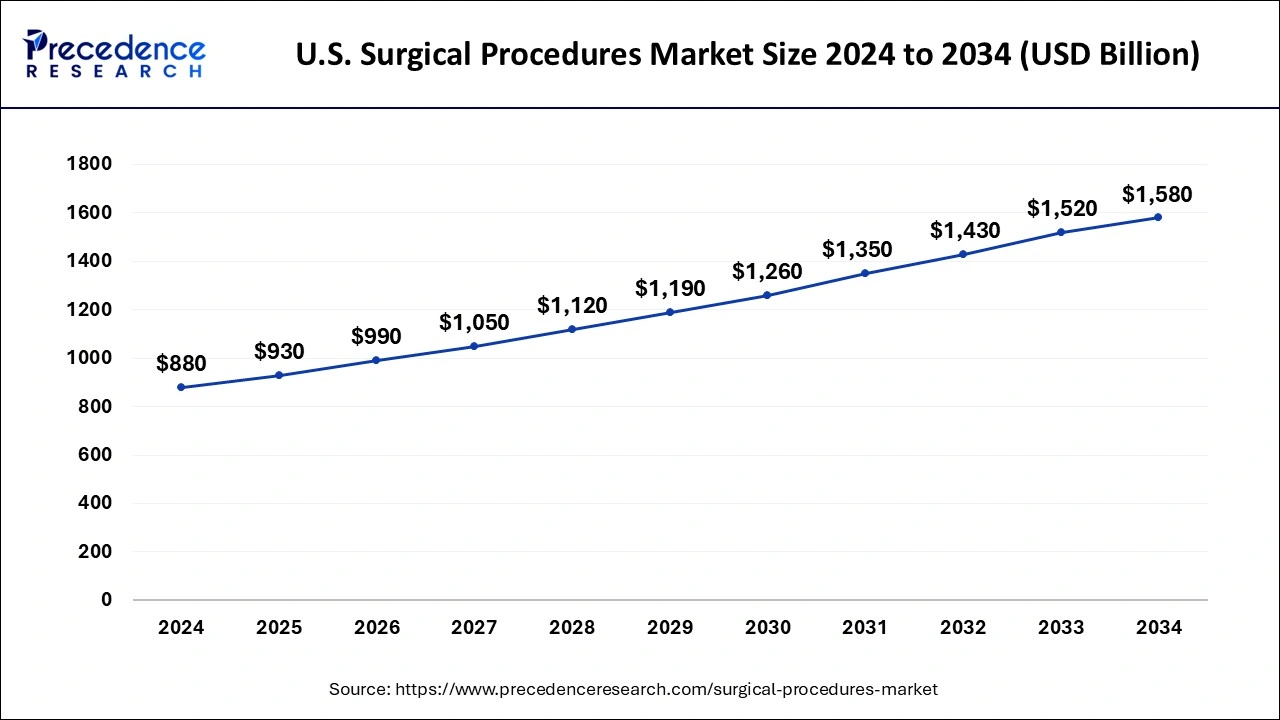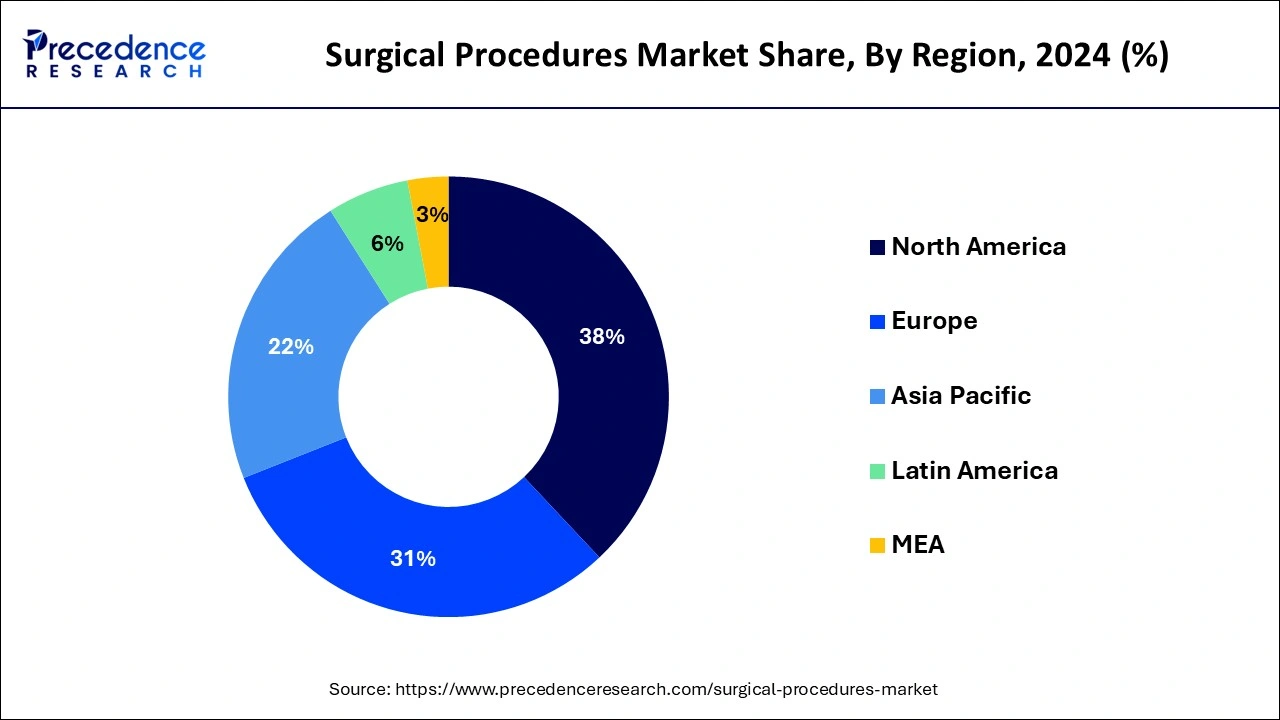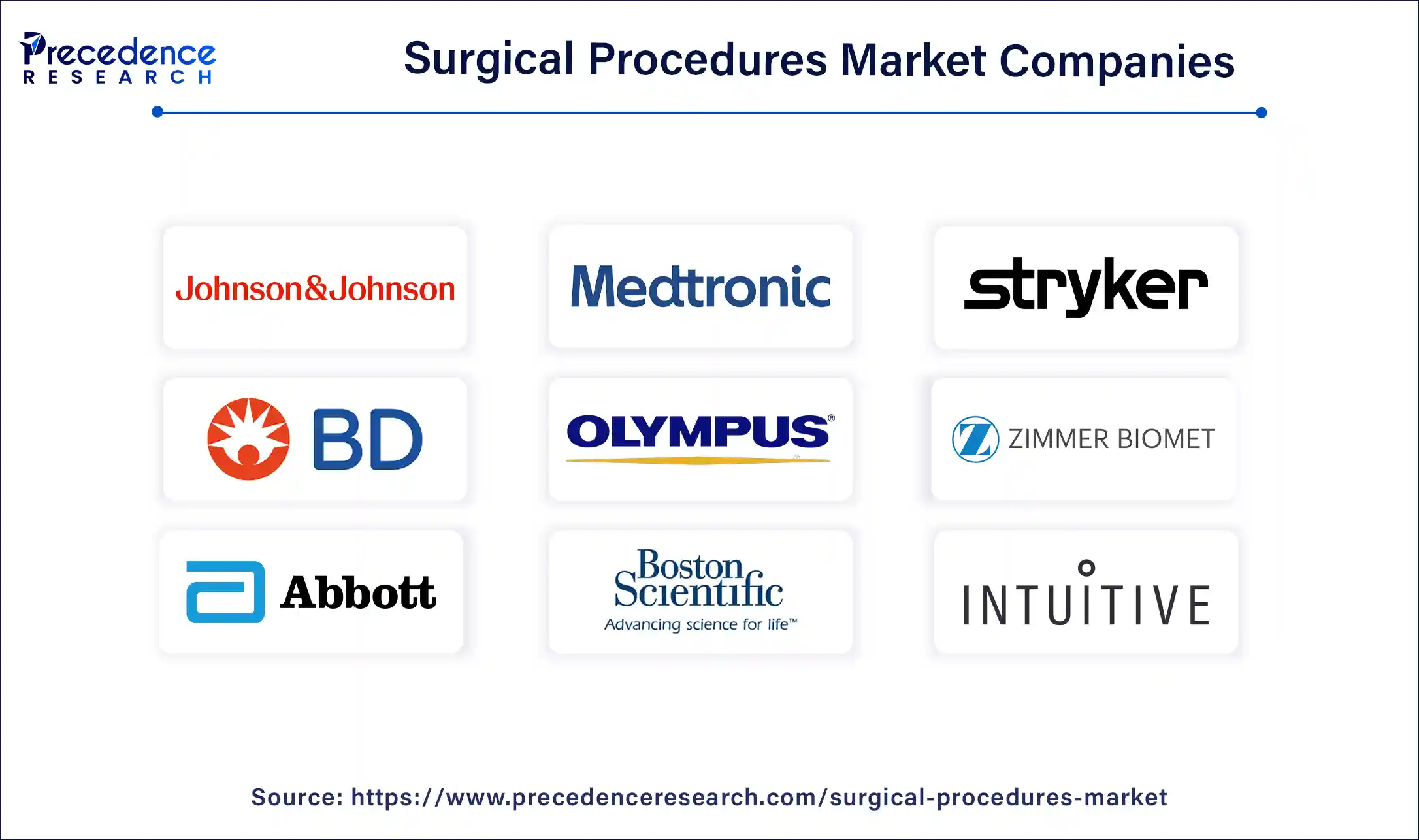Surgical Procedures Market Size and Forecast 2025 to 2034
The global surgical procedures market size was accounted for USD 3.35 trillion in 2024, and is expected to reach around USD 5.80 trillion by 2034, expanding at a CAGR of 5.64% from 2025 to 2034. The surgical procedures market is expanding due to technological advancements in surgical tools, rising geriatric populations, and chronic health conditions, which are propelling the market's growth.

Surgical Procedures Market Key Takeaways
- The global surgical procedures market was valued at USD 3.35 trillion in 2024.
- It is projected to reach USD 5.80 trillion by 2034.
- The surgical procedures market is expected to grow at a CAGR of 5.64% from 2025 to 2034.
- North America contributed more than 38% of revenue share in 2024.
- Asia Pacific is estimated to expand the fastest CAGR between 2025 and 2034.
- By type, the cardiovascular segment has held the largest market share of 24% in 2024.
- By type, the orthopedic segment is anticipated to grow at a remarkable CAGR of 6.2% between 2025 and 2034.
- By channel, the hospitals segment generated over 45% of revenue share in 2024.
- By channel, the physician offices segment is expected to expand at the fastest CAGR over the projected period.
The Impact of Artificial Intelligence in the Surgical Procedures Market
AI is impacting the surgical procedures market in various ways, including enhancing surgical precision using AI, post-surgical care, and assisting healthcare professionals. AI possesses immense potential to transform surgical methods with unprecedented accuracy, efficiency, and patient care. Advanced algorithms can analyze comprehensive medical data, which aids surgeons in making data-based decisions. By considering the patient's unique medical history, AI-driven tools can solve complications and advise on the optimal surgical approach, showcasing a significant forward leap in surgical care.
Moreover, AI's role extends to post-surgical care by beating the odds of the traditional human care method. AI-driven post-care tools can track recovery on-time medications and easily identify health complications. Such a proactive approach ensures reduced re-admission and aids in faster recovery.
U.S. Surgical Procedures Market Size and Growth 2025 to 2034
The U.S. surgical procedures market size was estimated at USD 880 billion in 2024 and is predicted to be worth around USD 1580 billion by 2034, at a CAGR of 6.03% from 2025 to 2034.

North America has held the largest revenue share of 38% in 2024. North America holds a major share in the surgical procedures market due to robust healthcare infrastructure, advanced medical technologies, and high healthcare spending. The region benefits from a well-established surgical ecosystem, including skilled healthcare professionals and cutting-edge surgical facilities. Additionally, a growing aging population and the prevalence of chronic diseases contribute to the demand for various surgical interventions. Favorable reimbursement policies and a strong focus on healthcare innovation further solidify North America's position as a leader in the global surgical procedures market.

Asia Pacific is estimated to witness the highest growth. Asia Pacific commands a significant share in the surgical procedures market due to factors such as a large patient population, rising healthcare investments, and increasing access to advanced medical technologies. The region experiences a surge in demand for surgical interventions driven by lifestyle changes, aging populations, and a growing incidence of chronic diseases. Additionally, improvements in healthcare infrastructure and a focus on medical tourism contribute to the expansion of the surgical procedures market in Asia Pacific, making it a key player in the global landscape.
Market Overview
Surgical procedures are diverse medical interventions involving incisions or tissue manipulation to diagnose, treat, or prevent health conditions. They fall into categories like elective (planned), emergency (urgent), and minimally invasive surgeries. Elective surgeries, such as joint replacements, enhance patients' quality of life through planned interventions. Emergency surgeries address critical conditions requiring immediate action.
Minimally invasive techniques, like laparoscopy, use smaller incisions and specialized tools, reducing recovery time and scarring. Skilled surgeons, often part of a healthcare team, conduct these procedures. Constant innovation in technology, materials, and techniques shapes the field, continually improving patient care globally. Surgical procedures play a pivotal role in advancing medical science, demonstrating the dynamic nature of healthcare practices.
Surgical Procedures Market Growth Factors
- Technological Advancements: Continuous innovation in surgical technologies, such as robotic-assisted procedures and advanced imaging systems, is driving the growth of the surgical procedures market.
- Aging Population: The increasing global aging population contributes to higher demand for surgical interventions as older individuals often require medical procedures to address age-related health issues.
- Rising Chronic Diseases: The prevalence of chronic diseases necessitates surgical interventions for treatment and management, boosting the overall demand for surgical procedures.
- Global Health Infrastructure Development: Growing investments in healthcare infrastructure worldwide, particularly in emerging markets, support the expansion of surgical facilities and procedures.
- Minimally Invasive Techniques: The popularity of minimally invasive surgeries is on the rise, driven by benefits such as quicker recovery times, reduced scarring, and lower post-operative complications.
- Patient Preferences: Increasing awareness and acceptance of surgical treatments among patients, influenced by education and improved communication in healthcare, contribute to market growth.
- Government Initiatives: Supportive government policies and initiatives aimed at improving healthcare access and quality are fostering the growth of surgical procedures.
- Health Insurance Coverage: Expansion of health insurance coverage globally enables more individuals to afford surgical procedures, driving market growth.
- Global Medical Tourism: The rise of medical tourism encourages patients to seek surgical treatments abroad, boosting international demand for various procedures.
- Specialized Surgical Training: Surgeons' access to advanced training programs enhances their skills, fostering confidence in performing a wider array of surgical procedures.
- Personalized Medicine: Advancements in genomics and personalized medicine contribute to tailored surgical approaches, improving treatment outcomes and patient satisfaction.
- Regulatory Approvals: Streamlined regulatory processes for approving new surgical techniques and devices expedite market entry, promoting innovation.
- Awareness Campaigns: Public awareness campaigns about the benefits and accessibility of surgical procedures contribute to increased patient acceptance and demand.
- Collaborative Healthcare Models: Integration of multidisciplinary healthcare teams facilitates comprehensive pre- and post-operative care, enhancing the overall surgical experience.
- Globalization of Healthcare: Increased collaboration and information exchange between healthcare providers worldwide contribute to the standardization and improvement of surgical practices.
- Preventive Surgeries: Growing emphasis on preventive surgeries for conditions with a high genetic predisposition contributes to market expansion.
- Remote Surgical Technologies: The development of remote surgical technologies allows for procedures to be performed by experts in different locations, improving access to specialized care.
- Innovative Materials: The use of advanced materials in surgical procedures, such as biocompatible implants, enhances the efficacy and durability of interventions.
- Data Analytics in Surgery: Utilizing data analytics for surgical planning and post-operative analysis improves decision-making, leading to better surgical outcomes.
- Patient-Centric Approach: A shift towards a patient-centric approach in healthcare, with a focus on personalized treatment plans, is driving demand for tailored surgical solutions.
Market Scope
| Report Coverage | Details |
| Growth Rate from 2025to 2034 | CAGR of 5.64% |
| Market Size in 2025 | USD 3.54 Trillion |
| Market Size by 2034 | USD 5.80 Trillion |
| Largest Market | North America |
| Base Year | 2024 |
| Forecast Period | 2025 to 2034 |
| Segments Covered | By Type and By Channel |
| Regions Covered | North America, Europe, Asia-Pacific, Latin America, and Middle East & Africa |
Market Dynamics
Driver
Global health infrastructure development and patient preferences
The expansion of global health infrastructure plays a vital role in boosting the demand for surgical procedures. As countries invest in upgrading healthcare facilities, the availability of advanced surgical services increases, driving a greater need for various surgical interventions. Improved medical infrastructure, equipped with modern technology, becomes a key factor in the growth of the surgical procedures market. Simultaneously, changing patient preferences has a significant impact on market demand.
With a better understanding of healthcare options, patients increasingly favor surgical solutions that align with their individual needs. This includes a preference for minimally invasive procedures, personalized treatment approaches, and thorough pre-and post-operative care. The emphasis on patient-centric care is reshaping the landscape, influencing a higher acceptance and demand for surgical procedures, and encouraging healthcare providers to adapt to these evolving preferences.
Restraint
Limited access to healthcare and postoperative recovery time
Limited access to healthcare serves as a significant restraint on the demand for surgical procedures. In regions with inadequate healthcare infrastructure, individuals may face challenges in accessing necessary surgical interventions. This limitation stems from a lack of available medical facilities, skilled healthcare professionals, and resources, preventing a portion of the population from seeking or receiving surgical treatments. The resulting disparity in access hampers the overall growth potential of the surgical procedures market, creating barriers to healthcare equality.
Furthermore, the extended postoperative recovery time associated with certain surgical procedures acts as a deterrent for both patients and healthcare providers. Lengthy recovery periods can disrupt patients' daily lives and may lead individuals to opt for alternative, less invasive treatment options. The time commitment and potential impact on productivity and lifestyle choices contribute to hesitancy in choosing surgical interventions, influencing market demand. Addressing these challenges is crucial for ensuring broader accessibility to surgical procedures and improving overall market dynamics.
Opportunity
Advancements in robotic surgery and preventive surgery emphasis
Advancements in robotic surgery are pivotal in creating significant opportunities within the surgical procedures market. The continuous improvement and adoption of robotic-assisted surgical systems offer enhanced precision, reduced invasiveness, and shorter recovery times. This not only improves patient outcomes but also expands the range of surgeries that can be performed robotically. The evolving field of robotic surgery presents a niche for specialized procedures, attracting both patients and healthcare providers seeking advanced and efficient surgical solutions.
Simultaneously, the increasing emphasis on preventive surgeries represents a strategic opportunity for market growth. As healthcare systems shift towards proactive healthcare models, there is a growing focus on identifying and addressing health issues before they become more severe. This trend opens avenues for preventive surgeries, catering to high-risk populations or individuals with genetic predispositions. By promoting early intervention, this emphasis on prevention creates a unique space within the Surgical Procedures market, aligning with broader healthcare goals of improving long-term health outcomes and reducing the burden of chronic conditions.
Type Insights
In 2024, the cardiovascular segment held the highest market share of 24% on the basis of the type. In the surgical procedures market, the cardiovascular segment deals with surgeries related to the heart and blood vessels. This includes procedures like coronary artery bypass grafting and angioplasty. Current trends indicate a rising preference for less invasive methods, like transcatheter aortic valve replacement (TAVR), which shortens recovery periods and enhances patient results. The adoption of advanced technologies, such as robotic-assisted cardiac surgeries, underscores a noticeable shift towards innovative approaches in cardiovascular interventions within the overall realm of surgical procedures.
The orthopedic segment is anticipated to witness the highest growth at a significant CAGR of 6.2% during the projected period. In the surgical procedures market, the orthopedic segment deals with surgeries related to the musculoskeletal system, including joint replacements, fracture repairs, and spinal procedures. Current trends in orthopedic surgery emphasize the adoption of minimally invasive techniques like arthroscopy and robotic assistance, offering patients faster recovery and decreased post-operative discomfort. As the aging population contributes to a rise in orthopedic conditions, ongoing innovations in surgical methods and implant technologies are shaping the segment's growth, enhancing overall patient care and outcomes.
Channel Insights
According to the channel, the hospitals segment has held 45% revenue share in 2024. The hospital segment in the surgical procedures market refers to the channel where surgical interventions are primarily conducted within healthcare facilities. Hospitals serve as critical hubs for various surgical procedures, ranging from routine surgeries to complex interventions.
A notable trend in this segment includes an increasing adoption of advanced technologies, such as robotic-assisted surgery, to enhance precision and minimize invasiveness. Additionally, there's a growing emphasis on streamlined processes, interdisciplinary collaboration, and patient-centric care within hospital settings to optimize surgical outcomes and patient satisfaction.
The physician offices segment is anticipated to witness the highest growth over the projected period. The physician offices segment in the surgical procedures market refers to medical practices where physicians perform various surgeries. This channel is witnessing a trend towards increased in-office surgical procedures due to advancements in minimally invasive techniques, allowing for quicker recovery and reduced hospitalization.
Physicians are embracing technologies that enable them to conduct certain surgeries in their offices, offering convenience for patients and potential cost savings. This trend aligns with a broader shift towards outpatient and ambulatory surgical care in the healthcare landscape.
Surgical Procedures Market Companies

- Johnson & Johnson
- Medtronic
- Stryker Corporation
- Becton, Dickinson and Company (BD)
- Olympus Corporation
- Zimmer Biomet
- Abbott Laboratories
- Boston Scientific Corporation
- Ethicon (a subsidiary of Johnson & Johnson)
- Intuitive Surgical
- Smith & Nephew
- Cook Medical
- Karl Storz
- Terumo Corporation
- CONMED Corporation
Recent Developments
- On 13th January 2025, India's indigenous surgical robot system, known as SSI mantra, successfully conducted two robotic cardiac surgeries with the help of telesurgery procedures.
- On 16th October 2024, Horizon Surgical Systems Inc., a privately held micro-robotics firm advancing microsurgery with automated AI-enabled robotics, announced a US$ 30 million series A financing. This is led by Exsight ventures and a major corporate investor.
Segments Covered in the Report
By Type
- Gastrointestinal
- Cardiovascular
- Dental, Cosmetic
- Urologic
- Ophthalmic
- Orthopedic
- ENT
- Nervous System
- Obstetric/Gynecologic
By Channel
- Physician Offices
- Hospitals
- ASCs
By Geography
- North America
- Europe
- Asia-Pacific
- Latin America
- Middle East and Africa
For inquiries regarding discounts, bulk purchases, or customization requests, please contact us at sales@precedenceresearch.com
Frequently Asked Questions
Ask For Sample
No cookie-cutter, only authentic analysis – take the 1st step to become a Precedence Research client
 sales@precedenceresearch.com
sales@precedenceresearch.com
 +1 804-441-9344
+1 804-441-9344